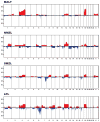Genomic analysis of marginal zone and lymphoplasmacytic lymphomas identified common and disease-specific abnormalities
- PMID: 22301699
- PMCID: PMC3341516
- DOI: 10.1038/modpathol.2011.213
Genomic analysis of marginal zone and lymphoplasmacytic lymphomas identified common and disease-specific abnormalities
Abstract
Lymphoplasmacytic lymphomas and marginal zone lymphomas of nodal, extra-nodal and splenic types account for 10% of non-Hodgkin lymphomas. They are similar at the cell differentiation level, sometimes making difficult to distinguish them from other indolent non-Hodgkin lymphomas. To better characterize their genetic basis, we performed array-based comparative genomic hybridization in 101 marginal zone lymphomas (46 MALT, 35 splenic and 20 nodal marginal zone lymphomas) and 13 lymphoplasmacytic lymphomas. Overall, 90% exhibited copy-number abnormalities. Lymphoplasmacytic lymphomas demonstrated the most complex karyotype (median=7 copy-number abnormalities), followed by MALT (4), nodal (3.5) and splenic marginal zone lymphomas (3). A comparative analysis exposed a group of copy-number abnormalities shared by several or all the entities with few disease-specific abnormalities. Gain of chromosomes 3, 12 and 18 and loss of 6q23-q24 (TNFAIP3) were identified in all entities. Losses of 13q14.3 (MIRN15A-MIRN16-1) and 17p13.3-p12 (TP53) were found in lymphoplasmacytic and splenic marginal zone lymphomas; loss of 11q21-q22 (ATM) was found in nodal, splenic marginal zone and lymphoplasmacytic lymphomas and loss of 7q32.1-q33 was found in MALT, splenic and lymphoplasmacytic lymphomas. Abnormalities affecting the nuclear factor kappa B pathway were observed in 70% of MALT and lymphoplasmacytic lymphomas and 30% of splenic and nodal marginal zone lymphomas, suggesting distinct roles of this pathway in the pathogenesis/progression of these subtypes. Elucidation of the genetic alterations contributing to the pathogenesis of these lymphomas may guide to design-specific therapeutic approaches.
Figures




References
-
- Harris NL, Jaffe ES, Diebold J, Flandrin G, Muller-Hermelink HK, Vardiman J, et al. The World Health Organization classification of neoplastic diseases of the hematopoietic and lymphoid tissues. Report of the Clinical Advisory Committee meeting, Airlie House, Virginia, November, 1997. Ann Oncol. 1999;10:1419–32. - PubMed
-
- Jaffe ES, Harris NL, Diebold J, Muller-Hermelink HK. World Health Organization classification of neoplastic diseases of the hematopoietic and lymphoid tissues. A progress report. Am J Clin Pathol. 1999;111:S8–12. - PubMed
-
- Fonseca R, Hayman S. Waldenstrom macroglobulinaemia. Br J Haematol. 2007;138:700–20. - PubMed
-
- Auer IA, Gascoyne RD, Connors JM, Cotter FE, Greiner TC, Sanger WG, et al. t(11;18)(q21;q21) is the most common translocation in MALT lymphomas. Ann Oncol. 1997;8:979–85. - PubMed
-
- Ott G, Katzenberger T, Greiner A, Kalla J, Rosenwald A, Heinrich U, et al. The t(11;18)(q21;q21) chromosome translocation is a frequent and specific aberration in low-grade but not high-grade malignant non-Hodgkin’s lymphomas of the mucosa-associated lymphoid tissue (MALT-) type. Cancer Res. 1997;57:3944–8. - PubMed
Publication types
MeSH terms
Substances
Grants and funding
LinkOut - more resources
Full Text Sources
Molecular Biology Databases
Research Materials
Miscellaneous

